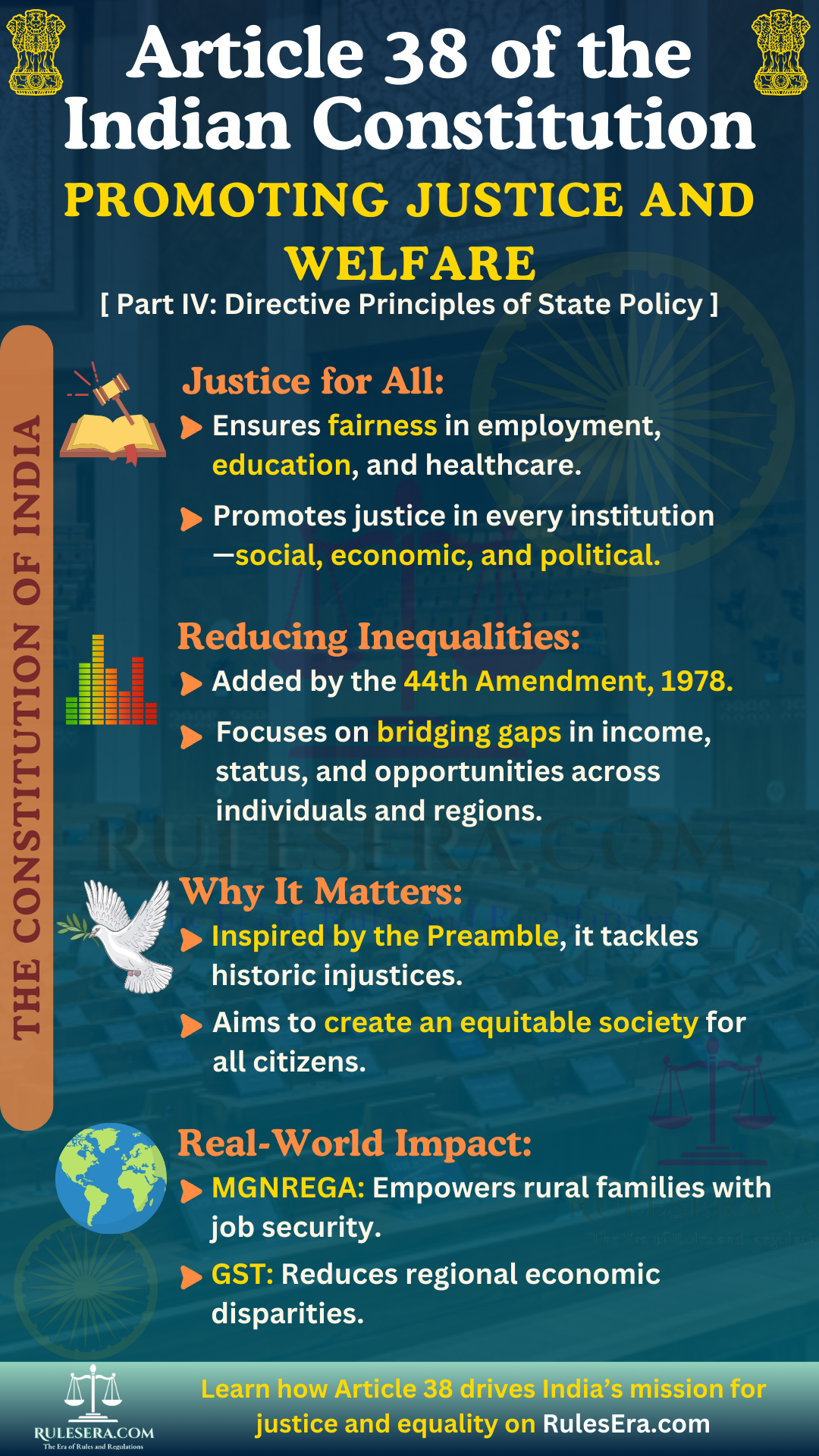Part IV: Directive Principles of State Policy
Article 38: State to secure a social order for the promotion of welfare of the people

--- Original Article ---
[(1)] The State shall strive to promote the welfare of the people by securing and protecting as effectively as it may a social order in which justice, social, economic, and political, shall inform all the institutions of the national life.
[(2)] The State shall, in particular, strive to minimize the inequalities in income, and endeavor to eliminate inequalities in status, facilities, and opportunities, not only amongst individuals but also amongst groups of people residing in different areas or engaged in different vocations.
Explanation
Article 38 of the Indian Constitution is part of the Directive Principles of State Policy (DPSP), a guiding framework for governance that aims to ensure the establishment of a just and equitable social order. It reflects the constitutional commitment to promoting the welfare of all citizens by minimizing social, economic, and political inequalities.
Clause (1): Ensuring Justice in All National Institutions
This clause mandates the State to promote the welfare of the people by creating and maintaining a social order that is based on justice—social, economic, and political. Every institution in India, whether governmental or private, should work towards creating a fair and just society, ensuring that every citizen has access to basic needs and opportunities without discrimination.
Historical Significance
This clause draws inspiration from the Constitution’s Preamble, which outlines justice as a key objective of the Indian state. Post-independence, the framers of the Constitution sought to address the deep social inequalities. Article 38 represents a commitment to reversing these historical injustices.
Real-Life Example
An example is the Mahatma Gandhi National Rural Employment Guarantee Act (MGNREGA), which guarantees 100 days of wage employment to rural households, promoting social and economic justice.
Clause (2): Minimizing Income and Social Inequalities
The second clause directs the State to strive toward minimizing inequalities in income, status, facilities, and opportunities. This clause expands the State's role in addressing disparities between various groups and regions.
Amendment Insight
This clause was introduced through the Constitution (Forty-fourth Amendment) Act, 1978, reflecting a focus on income disparities and regional imbalances. It reinforced the idea that addressing social and economic disparities is essential for a just society.
Real-Life Example
An example of this clause in action is the Goods and Services Tax (GST), which aimed to simplify India’s tax structure and reduce regional inequalities by creating a uniform tax system.
Legislative History
Article 38 was first introduced as Article 30 of the Draft Constitution and discussed on November 19, 1948. It directs the State to promote social justice and reduce inequalities.
Debates and Deliberations
Shri Damodar Swarup Seth proposed an amendment advocating for a democratic socialist order, which was rejected. Mr. Naziruddin Ahmad suggested removing "strive to," while Dr. B.R. Ambedkar defended the phrase as necessary for flexibility. Shri Mahboob Ali Baig Sahib Bahadur criticized embedding specific ideologies in the Constitution.
Frequently Asked Questions (FAQs):
It emphasizes the State's responsibility to secure a social order based on justice and reduce inequalities.
Through policies like MGNREGA and GST, the State seeks to reduce disparities and promote welfare.